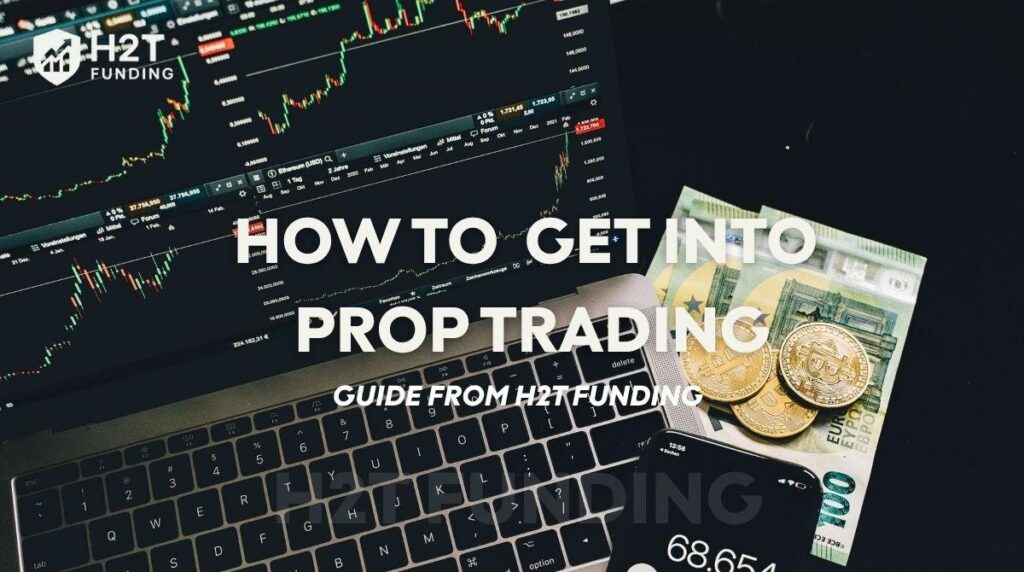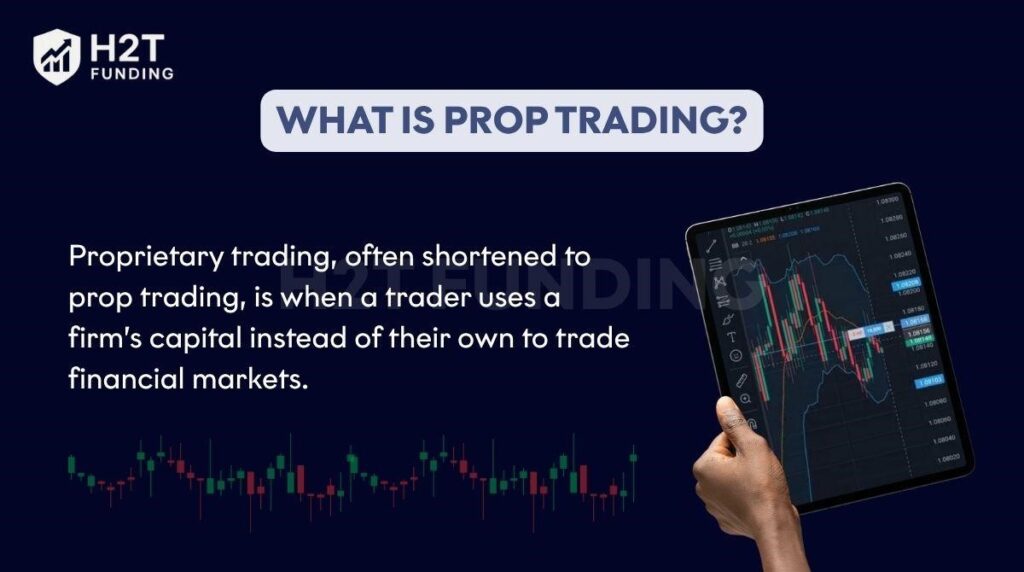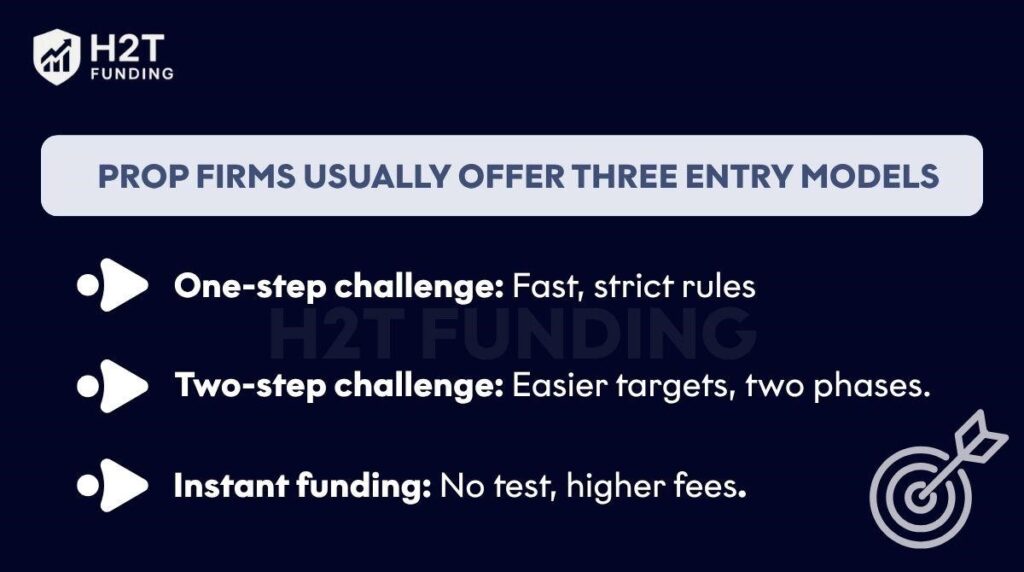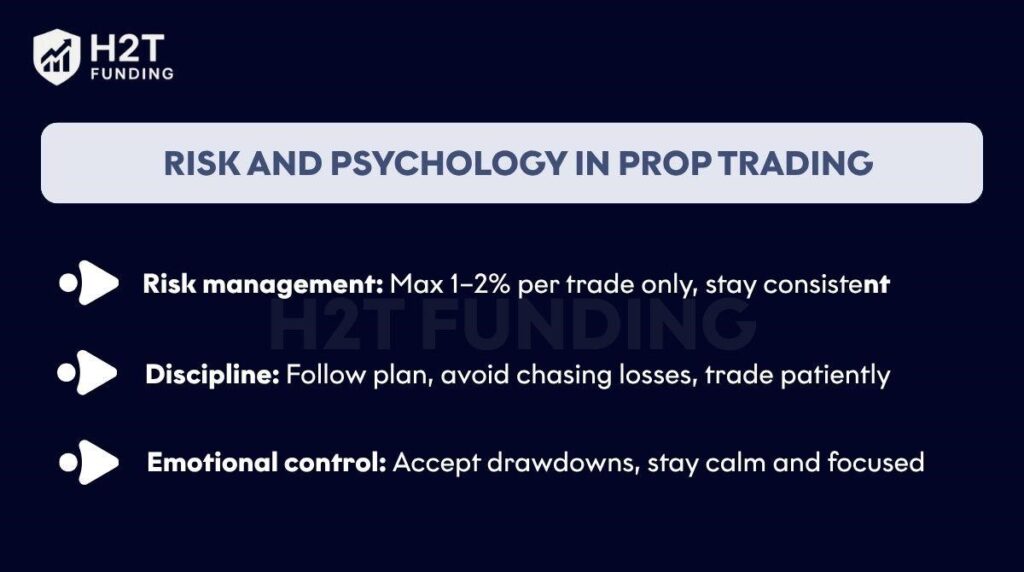
Thumbnail
Prop trading has become one of the fastest-growing ways for skilled traders to access large amounts of capital without risking their own savings.
If you’re wondering how to get into prop trading, this guide breaks down the exact steps, from skill preparation to passing evaluations and scaling accounts. You’ll also learn about the key rules, costs, and realistic expectations every trader should know before joining a prop trading firm.
Let’s start with the basics.
1. What is prop trading?
Proprietary trading, often shortened to prop trading, is when a trader uses a firm’s capital instead of their own to trade financial markets. In return, the trader shares a portion of the profits with the firm.

What is prop trading?
The main difference between prop trading and trading your own money is risk exposure. With personal accounts, losses directly affect your savings. In prop trading, the firm absorbs the risk, but you must follow their rules to keep the account.
As Investopedia (2023) explains, prop firms design their models around “controlled risk and profit sharing,” ensuring both the firm and trader benefit. This structure makes prop trading attractive for individuals with strong skills but limited capital.
2. How to get into prop trading: Step-by-step roadmap
Getting started with a prop trading firm requires more than ambition. It takes preparation, discipline, and a clear plan. Before looking at the details, here are the main steps most successful traders follow, especially those aiming to qualify with the easiest prop firms to pass:
- Step 1: Confirm your skills and consistency with demo trading
- Step 2: Decide between 1-step, 2-step, or instant funding programs
- Step 3: Research firms for rules, fees, and credibility
- Step 4: Prepare to follow evaluation rules (profit targets, loss limits, minimum days)
- Step 5: Build a plan for funded trading and scaling once you pass
Let’s look at each step in detail, starting with readiness checks and progressing all the way to trading a funded account.
2.1. Step 1 – Readiness check: skills, discipline, and demo results
Before applying, ensure you can show consistent results on a demo account. A prop firm wants proof that you can manage risk, follow rules, and control emotions.
From my own experience, keeping a detailed trading journal helped me identify weak spots in discipline, like overtrading after a loss. Addressing these issues early dramatically increased my chances of passing evaluations later.
Key readiness checks include:
- Consistent profitability over at least 2–3 months of demo trading
- Using stop-loss orders on every trade
- Documented trade journal with win rate and risk-to-reward ratio
- Emotional stability after both wins and losses
2.2. Step 2 – Choose your route: 1-step, 2-step, or instant funding
Prop firms usually offer three entry models:

Choose your route: 1-step, 2-step, or instant funding
- One-step challenge: Quick, but strict rules. Best for scalpers who want fast results.
- Two-step challenge: Lower targets across two phases. Many traders find this route more forgiving.
- Instant funding: No evaluation, but higher upfront fees.
I’ve noticed that beginners tend to perform better in two-step programs. The extra time allows for mistakes without immediate disqualification.
2.3. Step 3 – Pick a firm: rules, fees, and reputation
Not all firms are equal. Look at their credibility, evaluation fees, and payout history.
A reliable firm should offer:
- Transparent rules (drawdown limits, profit targets)
- Reasonable evaluation costs
- Positive trader feedback on platforms like Trustpilot or Reddit
- Proven payout history
H2T Funding’s analysis shows that most traders succeed when they prioritize rule clarity over flashy marketing promises.
2.4. Step 4 – Pass the evaluation: managing drawdown, targets, and time
This is where traders often struggle. Firms typically require:
- Profit targets (e.g., 8–10%)
- Daily loss limits (around 5%)
- Overall drawdown caps (often 10%)
- Minimum trading days (5–10)
When I took my first challenge, I failed by ignoring the daily loss limit. The lesson? Risk management matters more than hitting the target quickly.
2.5. Step 5 – Trade-funded account & scale: payouts and growth
Once funded, you trade live capital with real payout potential. Most firms pay monthly, while some offer bi-weekly withdrawals. Scaling programs reward consistent traders with larger account sizes.
Practical tips for funded trading:
- Stick to the same risk management that passed your evaluation
- Withdraw profits regularly, don’t chase oversized gains
- Focus on building account longevity instead of quick wins
As Jack Schwager highlighted in Market Wizards (2012), “Longevity in the market is the ultimate edge.” This is especially true in prop trading.
3. Key rules that decide pass/fail
Every trader researching how to get into prop trading must understand the rules that firms use to protect their capital. Breaking these conditions almost always leads to disqualification. Knowing them in advance is just as important as technical skills.
3.1. Core rules in prop trading evaluations
The most common rules include:
- Maximum drawdown: A hard cap on losses, often 8–10% of account equity.
- Daily loss limit: Restricts how much you can lose in a single day, usually 4–5%.
- Profit target: The minimum profit needed to pass evaluation, typically 8–10%.
- Minimum trading days: Forces consistency; most firms require 5–10 active days.
In my early challenges, I realized that focusing too much on the profit target made me reckless. Once I shifted focus to staying within the loss limits, passing became much easier.
3.2. Common mistakes that lead to failure
Even traders who already know how to get into a prop trading firm can still fail by making avoidable errors. Based on trader feedback and my own experience, the biggest pitfalls are:
- Ignoring the daily loss cap and trying to “win it back” in one session
- Overleveraging to hit targets faster
- Trading for too few days and violating the minimum activity rules
- Forgetting about news-related volatility that spikes losses
As the CFTC (2023) reminds traders, “risk controls are not optional; they are essential safeguards.” Respecting these boundaries is the only way to survive and thrive in prop trading.
4. Costs and payouts simplified
Prop trading may look like a shortcut to big capital, but it comes with upfront costs and structured payout cycles. Understanding these numbers helps you plan realistically.
The first cost is the evaluation fee, which ranges from $100 to several hundred dollars, depending on account size. If you break the rules during evaluation, you often need to pay a reset fee to try again. On top of this, some firms charge extra for platform access (like MetaTrader or TradingView add-ons) and real-time market data, especially in futures trading.
Once funded, you trade with the firm’s money and earn a share of profits. Most firms pay tra ders monthly, while some allow bi-weekly withdrawals. Calculating your break-even point is essential.
ders monthly, while some allow bi-weekly withdrawals. Calculating your break-even point is essential.
For example, if your evaluation fee was $500, your first $500 payout simply covers costs. Only after that are you in net profit.
A practical takeaway: treat these fees as an investment in your trading career. As long as your risk management keeps you funded, the payout potential can outweigh the initial expenses.
5. Risk and psychology in prop trading
Trading with a firm’s money doesn’t remove emotional pressure. In fact, many traders feel more stressed knowing they could lose access to their funded account after one mistake. Managing psychology is just as important as technical skills.
Risk and psychology in prop trading
Key areas to focus on include:
- Risk management: Never risk more than 1–2% per trade, even if the rules allow more.
- Discipline: Stick to your plan instead of chasing losses or forcing trades.
- Emotional control: Accept drawdowns as part of the process. Overreacting usually leads to breaking rules.
I once saw a trader pass an evaluation with ease but lose their funded account within two weeks because they doubled lot sizes after a losing streak. This shows how quickly emotions can undo a solid strategy.
As Alexander Elder wrote in Trading for a Living (2014), “The goal of a successful trader is to make the best trades. Money is secondary.” That mindset is what keeps traders consistent in prop trading.
6. Scaling and realistic expectations
Passing an evaluation is only the beginning. Most prop firms offer scaling plans that increase your account size once you prove consistent profitability. For example, some firms raise capital by 25–50% after a trader reaches specific milestones without breaking rules.
It’s important to keep expectations realistic. Even with scaling, most traders will not withdraw huge profits within the first month. A typical timeline to the first payout is 30–60 days, and scaling may take several months.
From my own journey, focusing on steady 2–3% monthly gains was more sustainable than chasing double-digit returns. This slower approach allowed me to qualify for scaling programs while avoiding unnecessary stress.
The real win in prop trading is longevity. By maintaining discipline and following the firm’s rules, scaling becomes a natural byproduct of consistent performance rather than a rushed goal.
7. About H2T Funding – Choose the Best Prop Firm to Get Funded
H2T Funding was founded in 2025 with a mission to support traders through clear, reliable, and unbiased insights into proprietary trading firms. In a market where complex contracts and aggressive marketing are common, H2T Funding has become a trusted resource for traders across more than 150 countries.
Staying true to its vision, H2T Funding – Compare, Review & Choose the Best Prop Firm has become more than a tagline; it reflects the platform’s role in helping traders identify reliable firms and succeed in their funding journey.
Beyond written guides, the platform also extends its support through the official YouTube channel: youtube.com/@h2tfunding. There, traders can find explainers, firm reviews, and step-by-step tutorials designed to make complex topics easier to understand.
What makes H2T Funding stand out is its commitment to fairness and transparency. The platform focuses on four main areas:
- Prop Firm Reviews: Honest evaluations based on actual rules and verified trader feedback
- Prop Firm Rules: Clear explanations of profit splits, drawdown limits, and evaluation conditions
- Prop Firm & Trading Strategies: In-depth guides to help traders choose the right firm, master proven trading approaches, apply evaluation tips, and build long-term growth strategies
- Resources: Tools, guides, and updates that keep traders aware of new opportunities and industry changes
Behind H2T Funding is a professional team combining trading experience and publishing expertise:
- Do Duc Hoang – Co-Founder & CEO with more than 15 years of Forex trading experience at global banks
- Ethan Stroud – Content Director with a decade in financial publishing at Click Media (WPP Group)
- Tea H2T – Head of Content and Market Research Analyst
- Ngan Pham H2T – Content Creator with a background in economics and marketing
- Minh Chau – Content Writer focused on practical and concise financial research

H2T Funding Team
By combining expertise, transparency, and trader-first resources, H2T Funding serves as a strategic partner for both beginners and experienced traders looking to succeed in proprietary trading.
8. FAQs
Before joining a prop firm, many traders have similar questions. Here are clear answers to the most common ones:
8.1. Is 1-step or 2-step better for beginners?
A 2-step challenge is usually safer. The profit targets are smaller in each phase, which gives beginners more room to recover from mistakes.
8.2. How much money do you need to start prop trading?
You typically need between $100 and $500 to cover the evaluation fee. The exact amount depends on account size and the firm’s pricing model.
8.3. How long to get the first payout?
Most firms require 30 days of trading before the first withdrawal. Some allow bi-weekly payouts, but expect at least one month from the start of your funded account.
8.4. What happens if you fail the evaluation?
If you break the rules or miss targets, the account is terminated. Most firms allow you to pay a reset fee to try again with the same rules.
9. Conclusion
Learning how to get into prop trading is about following a clear roadmap: building skills, choosing the right firm, passing evaluations, and managing psychology. Success does not come from shortcuts, but from discipline and consistency.
From my own experience, the breakthrough came when I stopped chasing the fastest payout and instead focused on steady growth. That mindset not only helped me pass evaluations but also qualified me for scaling programs that multiplied my account size over time.
Ready to take the next step? Visit H2T Funding to explore expert reviews, strategies, and resources designed to help you choose the right prop firm and succeed in your challenge.
Contact information:
- Website: https://h2tfunding.com/
- Office address: LV 4, 4/567 Group 10, Hoa Lan 1 Residential Area, Thuan An, Binh Duong, Viet Nam
- Email:funding@gmail.com
- Fanpage: https://www.facebook.com/h2tfunding
- YouTube: https://www.youtube.com/@h2tfunding
- Office hours: Monday–Friday, 9:00 AM – 5:00 PM EST





